Analysis and Design of a Water Distribution System Upgrade Project
VerifiedAdded on 2022/08/17
|12
|3165
|15
Project
AI Summary
This project details the upgrade of an aging water distribution system installed in 1963, addressing its declining efficiency and the increased water demand of the community. The project involves designing a new, efficient system using WaterCAD for hydraulic modeling and analysis. The proposed technical solutions include optimizing the design, developing flushing plans, identifying water loss, and managing energy usage. The project follows a critical path analysis for effective management and includes the design of a modern centrifugal pumping system. A geotechnical investigation and electrical system upgrade are also part of the plan. The project's success is measured by maximizing velocity during flushing and minimizing energy costs. The evaluation includes performance analysis using the deterministic methodology. The project timeline includes milestones for project initiation, design, material purchasing, environmental protection, mechanical project planning, and system installation, with an emphasis on ensuring adequate water supply and efficient distribution.

ENGINEERING DESIGN
By Name
Course
Instructor
Institution
Location
Date
By Name
Course
Instructor
Institution
Location
Date
Paraphrase This Document
Need a fresh take? Get an instant paraphrase of this document with our AI Paraphraser
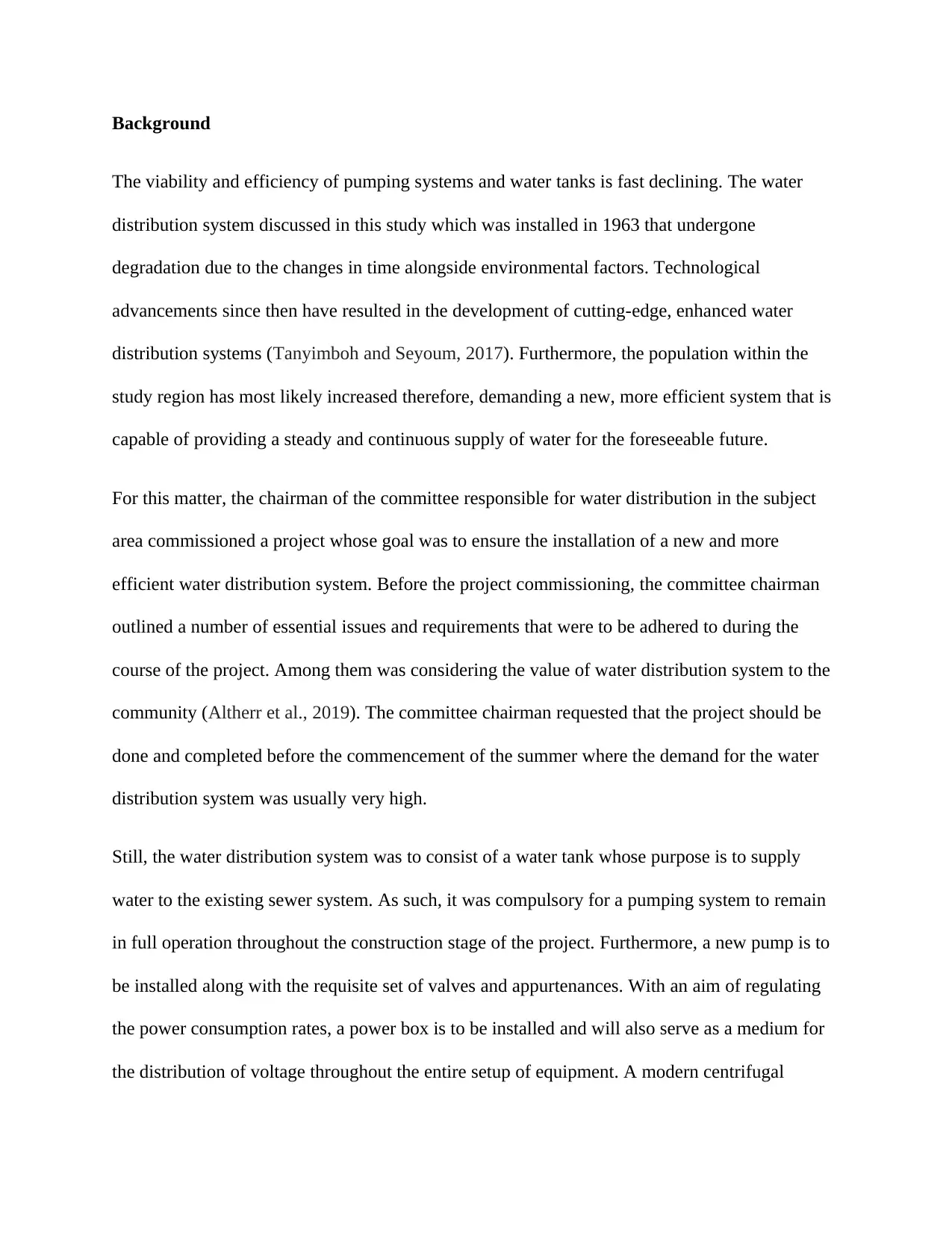
Background
The viability and efficiency of pumping systems and water tanks is fast declining. The water
distribution system discussed in this study which was installed in 1963 that undergone
degradation due to the changes in time alongside environmental factors. Technological
advancements since then have resulted in the development of cutting-edge, enhanced water
distribution systems (Tanyimboh and Seyoum, 2017). Furthermore, the population within the
study region has most likely increased therefore, demanding a new, more efficient system that is
capable of providing a steady and continuous supply of water for the foreseeable future.
For this matter, the chairman of the committee responsible for water distribution in the subject
area commissioned a project whose goal was to ensure the installation of a new and more
efficient water distribution system. Before the project commissioning, the committee chairman
outlined a number of essential issues and requirements that were to be adhered to during the
course of the project. Among them was considering the value of water distribution system to the
community (Altherr et al., 2019). The committee chairman requested that the project should be
done and completed before the commencement of the summer where the demand for the water
distribution system was usually very high.
Still, the water distribution system was to consist of a water tank whose purpose is to supply
water to the existing sewer system. As such, it was compulsory for a pumping system to remain
in full operation throughout the construction stage of the project. Furthermore, a new pump is to
be installed along with the requisite set of valves and appurtenances. With an aim of regulating
the power consumption rates, a power box is to be installed and will also serve as a medium for
the distribution of voltage throughout the entire setup of equipment. A modern centrifugal
The viability and efficiency of pumping systems and water tanks is fast declining. The water
distribution system discussed in this study which was installed in 1963 that undergone
degradation due to the changes in time alongside environmental factors. Technological
advancements since then have resulted in the development of cutting-edge, enhanced water
distribution systems (Tanyimboh and Seyoum, 2017). Furthermore, the population within the
study region has most likely increased therefore, demanding a new, more efficient system that is
capable of providing a steady and continuous supply of water for the foreseeable future.
For this matter, the chairman of the committee responsible for water distribution in the subject
area commissioned a project whose goal was to ensure the installation of a new and more
efficient water distribution system. Before the project commissioning, the committee chairman
outlined a number of essential issues and requirements that were to be adhered to during the
course of the project. Among them was considering the value of water distribution system to the
community (Altherr et al., 2019). The committee chairman requested that the project should be
done and completed before the commencement of the summer where the demand for the water
distribution system was usually very high.
Still, the water distribution system was to consist of a water tank whose purpose is to supply
water to the existing sewer system. As such, it was compulsory for a pumping system to remain
in full operation throughout the construction stage of the project. Furthermore, a new pump is to
be installed along with the requisite set of valves and appurtenances. With an aim of regulating
the power consumption rates, a power box is to be installed and will also serve as a medium for
the distribution of voltage throughout the entire setup of equipment. A modern centrifugal
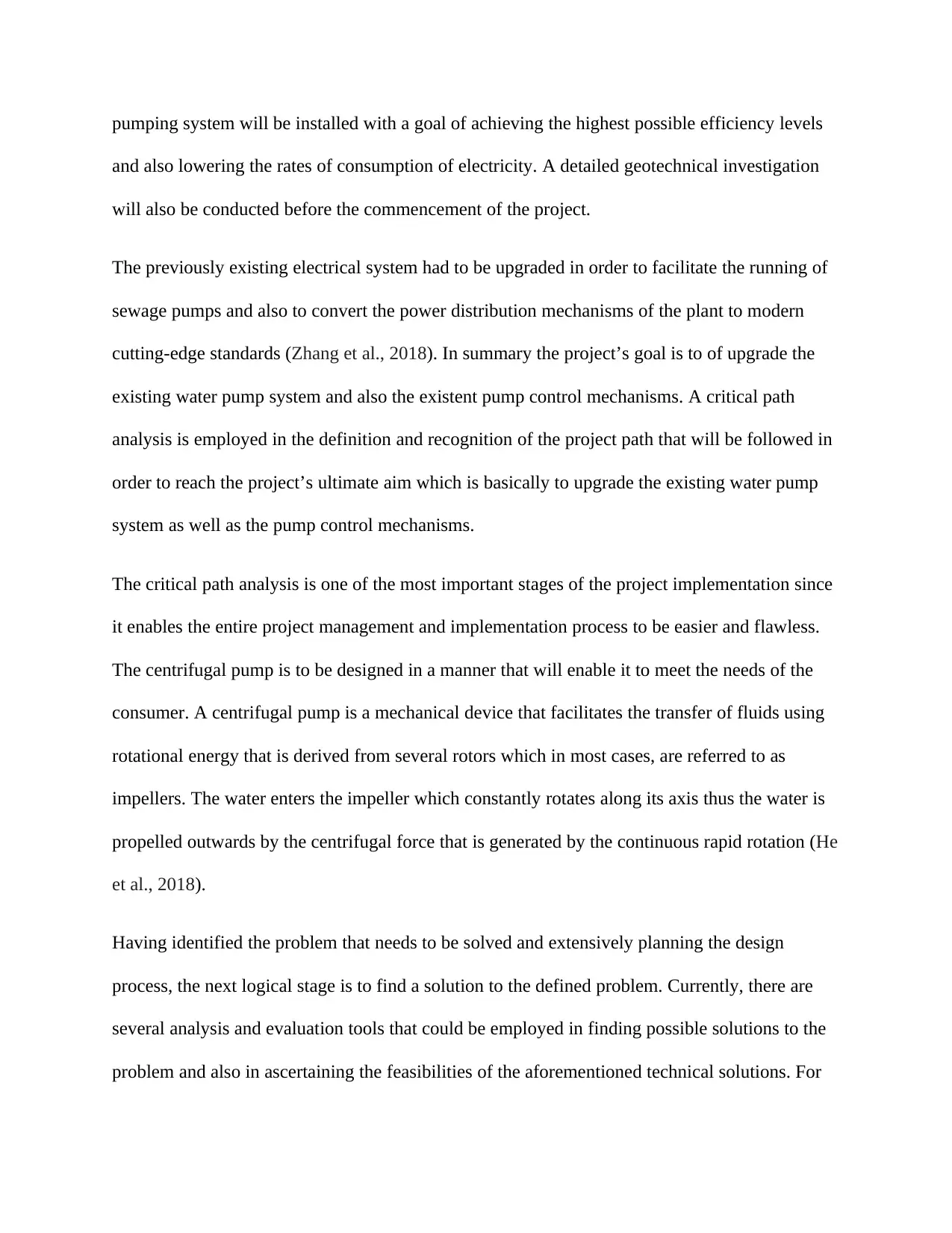
pumping system will be installed with a goal of achieving the highest possible efficiency levels
and also lowering the rates of consumption of electricity. A detailed geotechnical investigation
will also be conducted before the commencement of the project.
The previously existing electrical system had to be upgraded in order to facilitate the running of
sewage pumps and also to convert the power distribution mechanisms of the plant to modern
cutting-edge standards (Zhang et al., 2018). In summary the project’s goal is to of upgrade the
existing water pump system and also the existent pump control mechanisms. A critical path
analysis is employed in the definition and recognition of the project path that will be followed in
order to reach the project’s ultimate aim which is basically to upgrade the existing water pump
system as well as the pump control mechanisms.
The critical path analysis is one of the most important stages of the project implementation since
it enables the entire project management and implementation process to be easier and flawless.
The centrifugal pump is to be designed in a manner that will enable it to meet the needs of the
consumer. A centrifugal pump is a mechanical device that facilitates the transfer of fluids using
rotational energy that is derived from several rotors which in most cases, are referred to as
impellers. The water enters the impeller which constantly rotates along its axis thus the water is
propelled outwards by the centrifugal force that is generated by the continuous rapid rotation (He
et al., 2018).
Having identified the problem that needs to be solved and extensively planning the design
process, the next logical stage is to find a solution to the defined problem. Currently, there are
several analysis and evaluation tools that could be employed in finding possible solutions to the
problem and also in ascertaining the feasibilities of the aforementioned technical solutions. For
and also lowering the rates of consumption of electricity. A detailed geotechnical investigation
will also be conducted before the commencement of the project.
The previously existing electrical system had to be upgraded in order to facilitate the running of
sewage pumps and also to convert the power distribution mechanisms of the plant to modern
cutting-edge standards (Zhang et al., 2018). In summary the project’s goal is to of upgrade the
existing water pump system and also the existent pump control mechanisms. A critical path
analysis is employed in the definition and recognition of the project path that will be followed in
order to reach the project’s ultimate aim which is basically to upgrade the existing water pump
system as well as the pump control mechanisms.
The critical path analysis is one of the most important stages of the project implementation since
it enables the entire project management and implementation process to be easier and flawless.
The centrifugal pump is to be designed in a manner that will enable it to meet the needs of the
consumer. A centrifugal pump is a mechanical device that facilitates the transfer of fluids using
rotational energy that is derived from several rotors which in most cases, are referred to as
impellers. The water enters the impeller which constantly rotates along its axis thus the water is
propelled outwards by the centrifugal force that is generated by the continuous rapid rotation (He
et al., 2018).
Having identified the problem that needs to be solved and extensively planning the design
process, the next logical stage is to find a solution to the defined problem. Currently, there are
several analysis and evaluation tools that could be employed in finding possible solutions to the
problem and also in ascertaining the feasibilities of the aforementioned technical solutions. For
⊘ This is a preview!⊘
Do you want full access?
Subscribe today to unlock all pages.

Trusted by 1+ million students worldwide
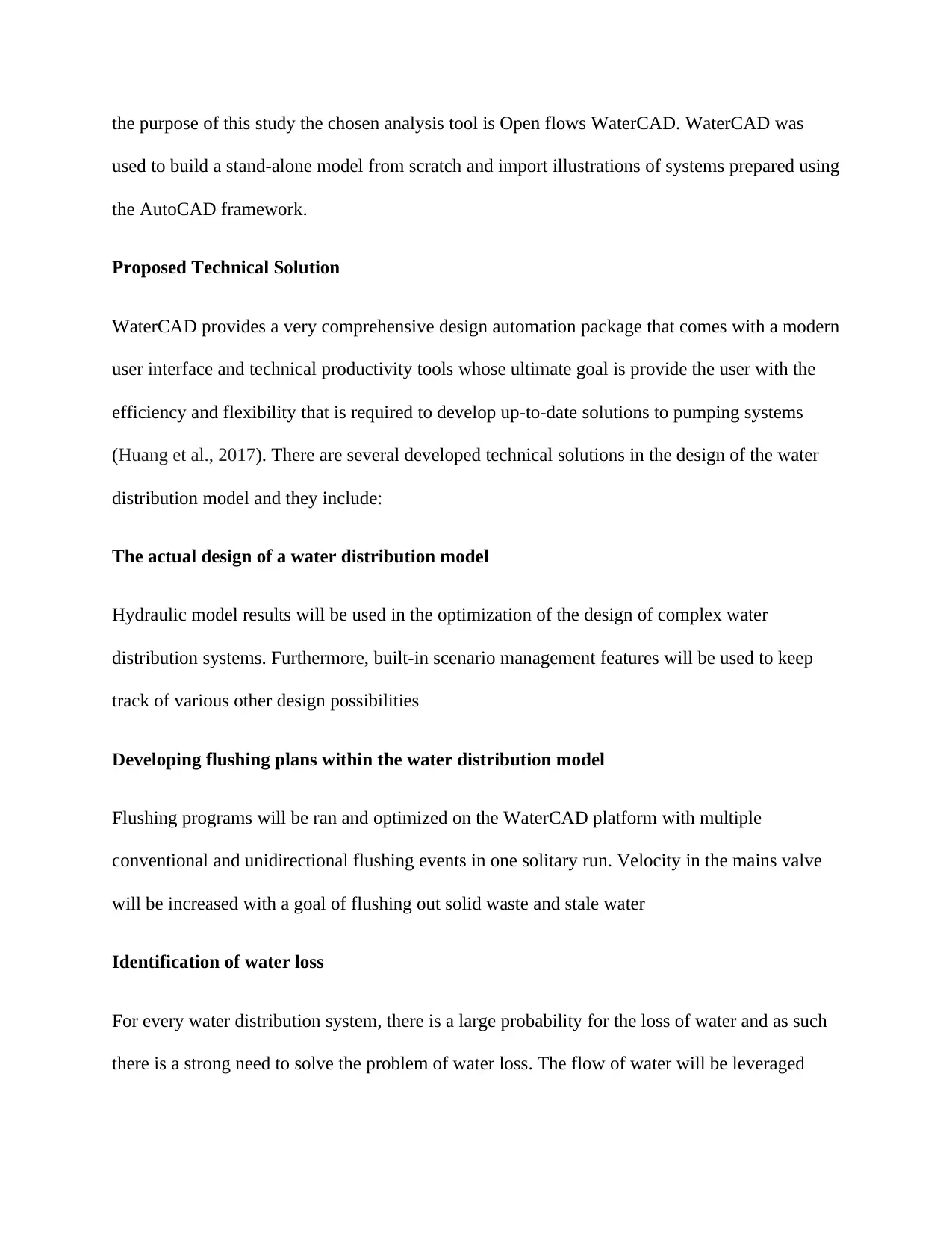
the purpose of this study the chosen analysis tool is Open flows WaterCAD. WaterCAD was
used to build a stand-alone model from scratch and import illustrations of systems prepared using
the AutoCAD framework.
Proposed Technical Solution
WaterCAD provides a very comprehensive design automation package that comes with a modern
user interface and technical productivity tools whose ultimate goal is provide the user with the
efficiency and flexibility that is required to develop up-to-date solutions to pumping systems
(Huang et al., 2017). There are several developed technical solutions in the design of the water
distribution model and they include:
The actual design of a water distribution model
Hydraulic model results will be used in the optimization of the design of complex water
distribution systems. Furthermore, built-in scenario management features will be used to keep
track of various other design possibilities
Developing flushing plans within the water distribution model
Flushing programs will be ran and optimized on the WaterCAD platform with multiple
conventional and unidirectional flushing events in one solitary run. Velocity in the mains valve
will be increased with a goal of flushing out solid waste and stale water
Identification of water loss
For every water distribution system, there is a large probability for the loss of water and as such
there is a strong need to solve the problem of water loss. The flow of water will be leveraged
used to build a stand-alone model from scratch and import illustrations of systems prepared using
the AutoCAD framework.
Proposed Technical Solution
WaterCAD provides a very comprehensive design automation package that comes with a modern
user interface and technical productivity tools whose ultimate goal is provide the user with the
efficiency and flexibility that is required to develop up-to-date solutions to pumping systems
(Huang et al., 2017). There are several developed technical solutions in the design of the water
distribution model and they include:
The actual design of a water distribution model
Hydraulic model results will be used in the optimization of the design of complex water
distribution systems. Furthermore, built-in scenario management features will be used to keep
track of various other design possibilities
Developing flushing plans within the water distribution model
Flushing programs will be ran and optimized on the WaterCAD platform with multiple
conventional and unidirectional flushing events in one solitary run. Velocity in the mains valve
will be increased with a goal of flushing out solid waste and stale water
Identification of water loss
For every water distribution system, there is a large probability for the loss of water and as such
there is a strong need to solve the problem of water loss. The flow of water will be leveraged
Paraphrase This Document
Need a fresh take? Get an instant paraphrase of this document with our AI Paraphraser
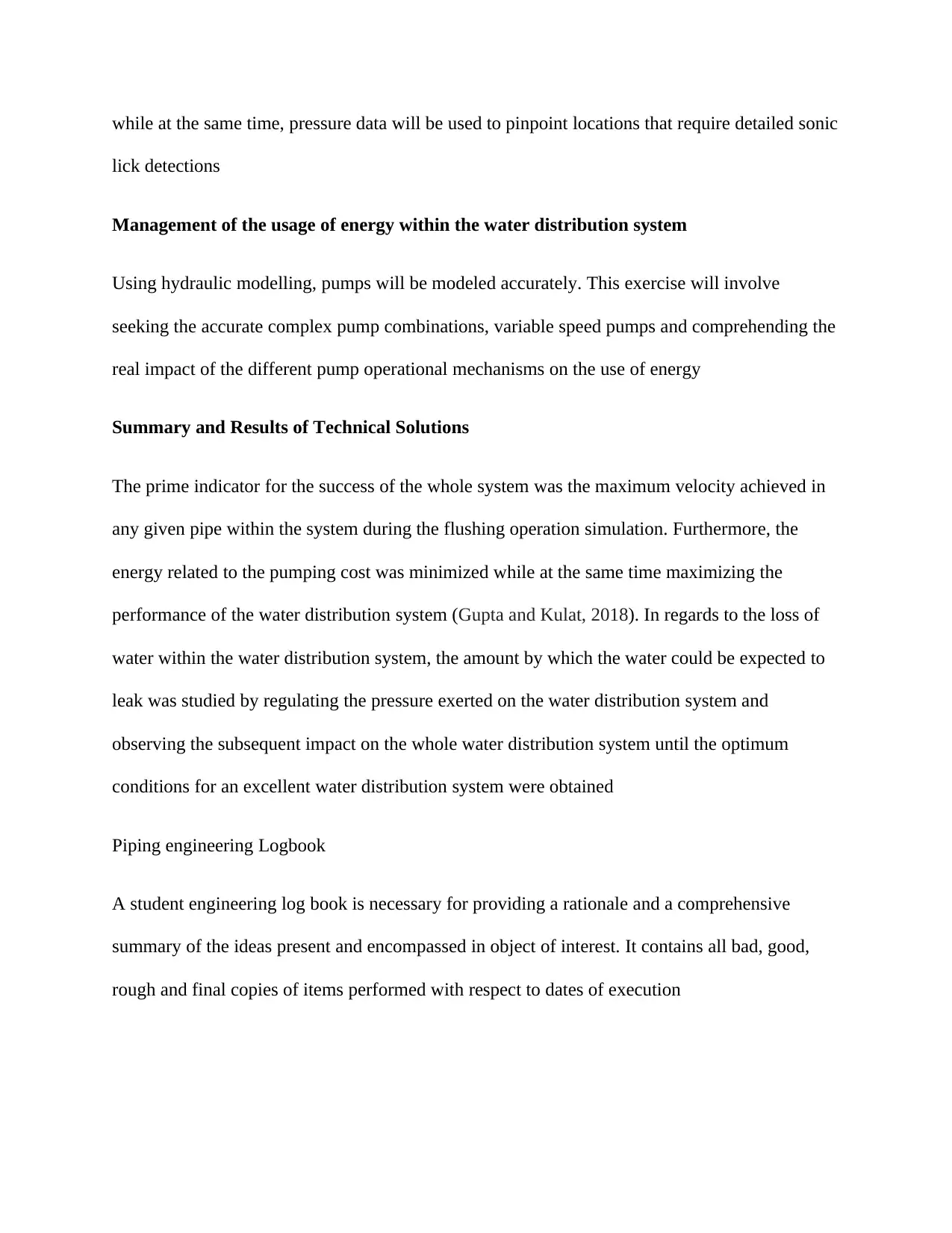
while at the same time, pressure data will be used to pinpoint locations that require detailed sonic
lick detections
Management of the usage of energy within the water distribution system
Using hydraulic modelling, pumps will be modeled accurately. This exercise will involve
seeking the accurate complex pump combinations, variable speed pumps and comprehending the
real impact of the different pump operational mechanisms on the use of energy
Summary and Results of Technical Solutions
The prime indicator for the success of the whole system was the maximum velocity achieved in
any given pipe within the system during the flushing operation simulation. Furthermore, the
energy related to the pumping cost was minimized while at the same time maximizing the
performance of the water distribution system (Gupta and Kulat, 2018). In regards to the loss of
water within the water distribution system, the amount by which the water could be expected to
leak was studied by regulating the pressure exerted on the water distribution system and
observing the subsequent impact on the whole water distribution system until the optimum
conditions for an excellent water distribution system were obtained
Piping engineering Logbook
A student engineering log book is necessary for providing a rationale and a comprehensive
summary of the ideas present and encompassed in object of interest. It contains all bad, good,
rough and final copies of items performed with respect to dates of execution
lick detections
Management of the usage of energy within the water distribution system
Using hydraulic modelling, pumps will be modeled accurately. This exercise will involve
seeking the accurate complex pump combinations, variable speed pumps and comprehending the
real impact of the different pump operational mechanisms on the use of energy
Summary and Results of Technical Solutions
The prime indicator for the success of the whole system was the maximum velocity achieved in
any given pipe within the system during the flushing operation simulation. Furthermore, the
energy related to the pumping cost was minimized while at the same time maximizing the
performance of the water distribution system (Gupta and Kulat, 2018). In regards to the loss of
water within the water distribution system, the amount by which the water could be expected to
leak was studied by regulating the pressure exerted on the water distribution system and
observing the subsequent impact on the whole water distribution system until the optimum
conditions for an excellent water distribution system were obtained
Piping engineering Logbook
A student engineering log book is necessary for providing a rationale and a comprehensive
summary of the ideas present and encompassed in object of interest. It contains all bad, good,
rough and final copies of items performed with respect to dates of execution
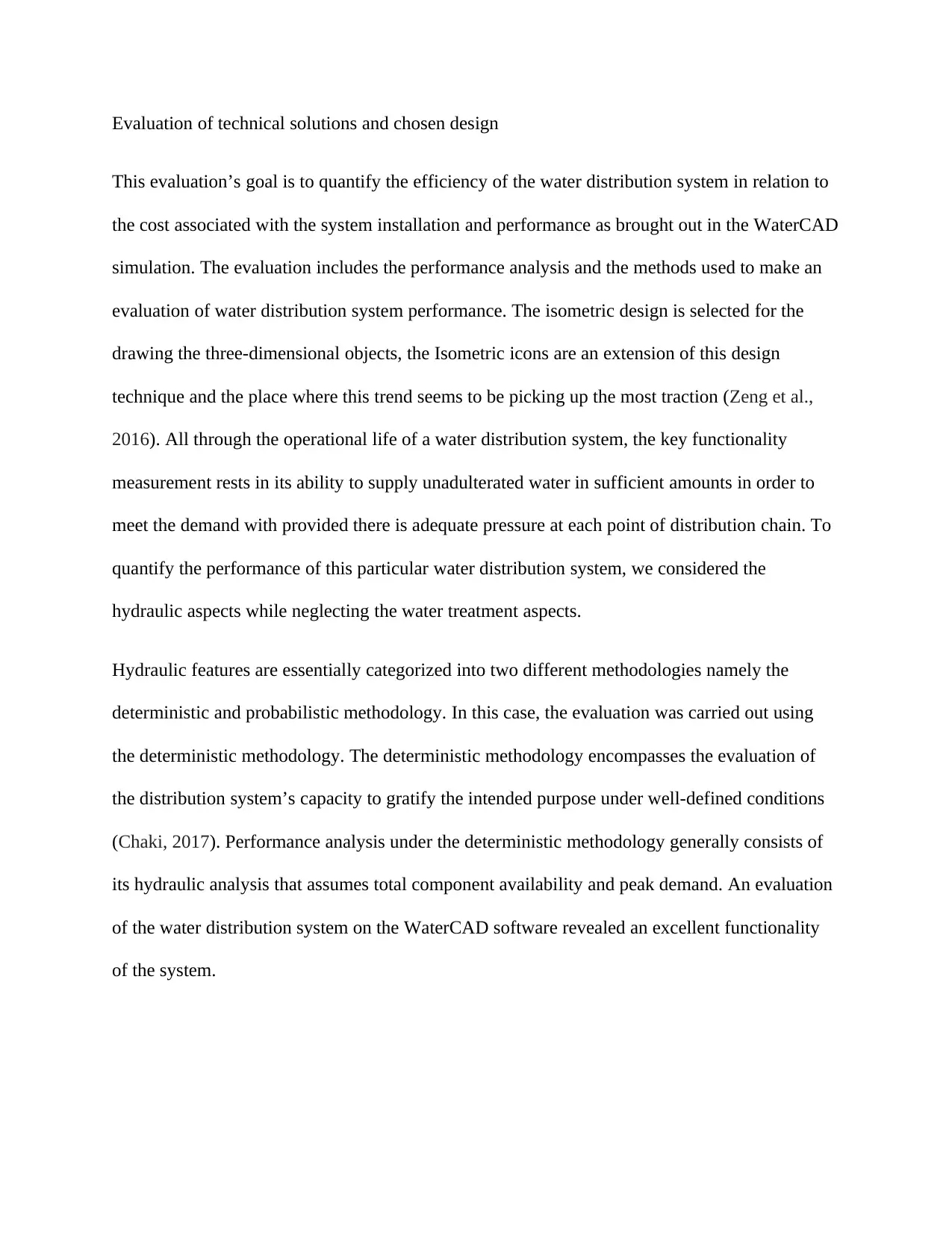
Evaluation of technical solutions and chosen design
This evaluation’s goal is to quantify the efficiency of the water distribution system in relation to
the cost associated with the system installation and performance as brought out in the WaterCAD
simulation. The evaluation includes the performance analysis and the methods used to make an
evaluation of water distribution system performance. The isometric design is selected for the
drawing the three-dimensional objects, the Isometric icons are an extension of this design
technique and the place where this trend seems to be picking up the most traction (Zeng et al.,
2016). All through the operational life of a water distribution system, the key functionality
measurement rests in its ability to supply unadulterated water in sufficient amounts in order to
meet the demand with provided there is adequate pressure at each point of distribution chain. To
quantify the performance of this particular water distribution system, we considered the
hydraulic aspects while neglecting the water treatment aspects.
Hydraulic features are essentially categorized into two different methodologies namely the
deterministic and probabilistic methodology. In this case, the evaluation was carried out using
the deterministic methodology. The deterministic methodology encompasses the evaluation of
the distribution system’s capacity to gratify the intended purpose under well-defined conditions
(Chaki, 2017). Performance analysis under the deterministic methodology generally consists of
its hydraulic analysis that assumes total component availability and peak demand. An evaluation
of the water distribution system on the WaterCAD software revealed an excellent functionality
of the system.
This evaluation’s goal is to quantify the efficiency of the water distribution system in relation to
the cost associated with the system installation and performance as brought out in the WaterCAD
simulation. The evaluation includes the performance analysis and the methods used to make an
evaluation of water distribution system performance. The isometric design is selected for the
drawing the three-dimensional objects, the Isometric icons are an extension of this design
technique and the place where this trend seems to be picking up the most traction (Zeng et al.,
2016). All through the operational life of a water distribution system, the key functionality
measurement rests in its ability to supply unadulterated water in sufficient amounts in order to
meet the demand with provided there is adequate pressure at each point of distribution chain. To
quantify the performance of this particular water distribution system, we considered the
hydraulic aspects while neglecting the water treatment aspects.
Hydraulic features are essentially categorized into two different methodologies namely the
deterministic and probabilistic methodology. In this case, the evaluation was carried out using
the deterministic methodology. The deterministic methodology encompasses the evaluation of
the distribution system’s capacity to gratify the intended purpose under well-defined conditions
(Chaki, 2017). Performance analysis under the deterministic methodology generally consists of
its hydraulic analysis that assumes total component availability and peak demand. An evaluation
of the water distribution system on the WaterCAD software revealed an excellent functionality
of the system.
⊘ This is a preview!⊘
Do you want full access?
Subscribe today to unlock all pages.

Trusted by 1+ million students worldwide
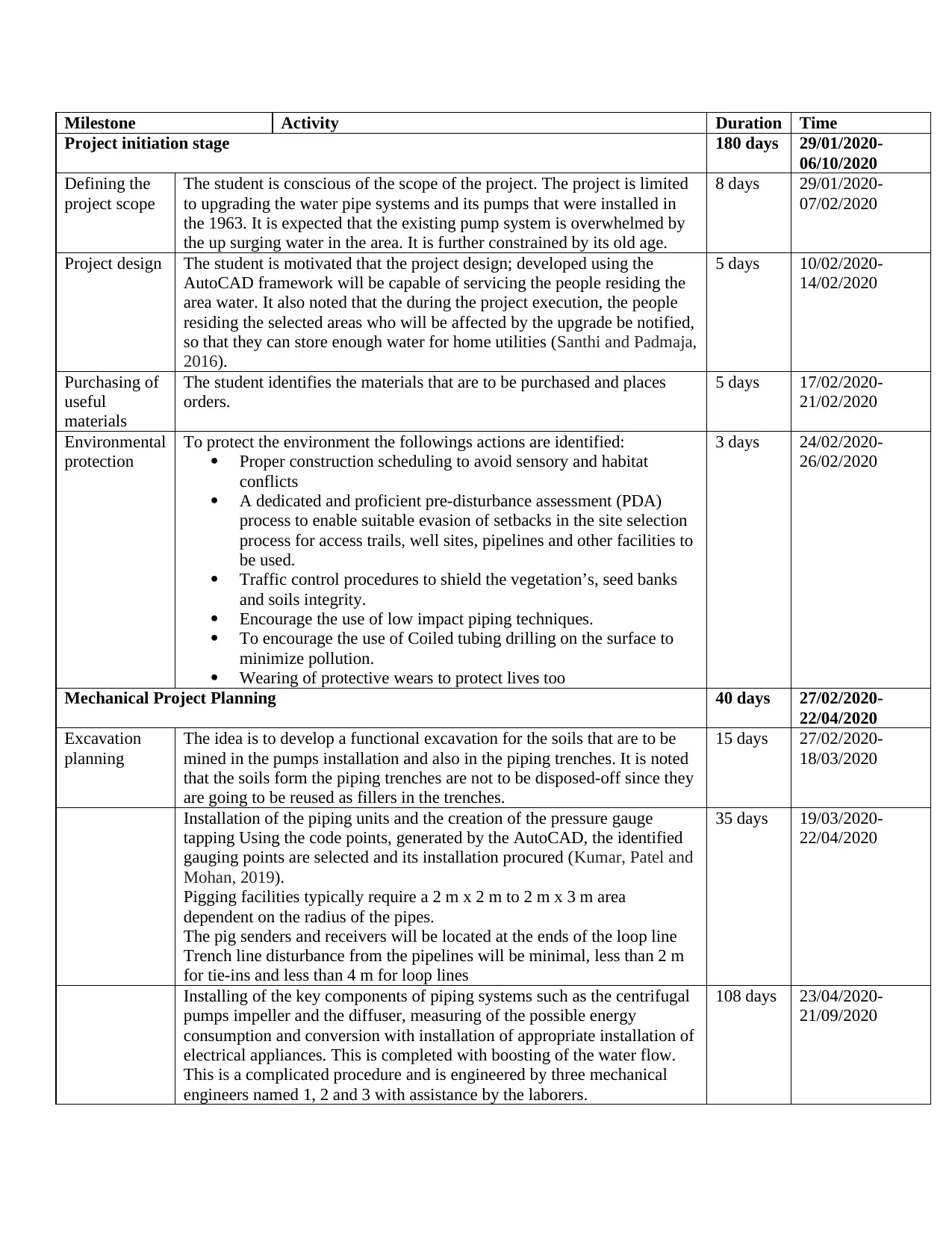
Milestone Activity Duration Time
Project initiation stage 180 days 29/01/2020-
06/10/2020
Defining the
project scope
The student is conscious of the scope of the project. The project is limited
to upgrading the water pipe systems and its pumps that were installed in
the 1963. It is expected that the existing pump system is overwhelmed by
the up surging water in the area. It is further constrained by its old age.
8 days 29/01/2020-
07/02/2020
Project design The student is motivated that the project design; developed using the
AutoCAD framework will be capable of servicing the people residing the
area water. It also noted that the during the project execution, the people
residing the selected areas who will be affected by the upgrade be notified,
so that they can store enough water for home utilities (Santhi and Padmaja,
2016).
5 days 10/02/2020-
14/02/2020
Purchasing of
useful
materials
The student identifies the materials that are to be purchased and places
orders.
5 days 17/02/2020-
21/02/2020
Environmental
protection
To protect the environment the followings actions are identified:
Proper construction scheduling to avoid sensory and habitat
conflicts
A dedicated and proficient pre-disturbance assessment (PDA)
process to enable suitable evasion of setbacks in the site selection
process for access trails, well sites, pipelines and other facilities to
be used.
Traffic control procedures to shield the vegetation’s, seed banks
and soils integrity.
Encourage the use of low impact piping techniques.
To encourage the use of Coiled tubing drilling on the surface to
minimize pollution.
Wearing of protective wears to protect lives too
3 days 24/02/2020-
26/02/2020
Mechanical Project Planning 40 days 27/02/2020-
22/04/2020
Excavation
planning
The idea is to develop a functional excavation for the soils that are to be
mined in the pumps installation and also in the piping trenches. It is noted
that the soils form the piping trenches are not to be disposed-off since they
are going to be reused as fillers in the trenches.
15 days 27/02/2020-
18/03/2020
Installation of the piping units and the creation of the pressure gauge
tapping Using the code points, generated by the AutoCAD, the identified
gauging points are selected and its installation procured (Kumar, Patel and
Mohan, 2019).
Pigging facilities typically require a 2 m x 2 m to 2 m x 3 m area
dependent on the radius of the pipes.
The pig senders and receivers will be located at the ends of the loop line
Trench line disturbance from the pipelines will be minimal, less than 2 m
for tie-ins and less than 4 m for loop lines
35 days 19/03/2020-
22/04/2020
Installing of the key components of piping systems such as the centrifugal
pumps impeller and the diffuser, measuring of the possible energy
consumption and conversion with installation of appropriate installation of
electrical appliances. This is completed with boosting of the water flow.
This is a complicated procedure and is engineered by three mechanical
engineers named 1, 2 and 3 with assistance by the laborers.
108 days 23/04/2020-
21/09/2020
Project initiation stage 180 days 29/01/2020-
06/10/2020
Defining the
project scope
The student is conscious of the scope of the project. The project is limited
to upgrading the water pipe systems and its pumps that were installed in
the 1963. It is expected that the existing pump system is overwhelmed by
the up surging water in the area. It is further constrained by its old age.
8 days 29/01/2020-
07/02/2020
Project design The student is motivated that the project design; developed using the
AutoCAD framework will be capable of servicing the people residing the
area water. It also noted that the during the project execution, the people
residing the selected areas who will be affected by the upgrade be notified,
so that they can store enough water for home utilities (Santhi and Padmaja,
2016).
5 days 10/02/2020-
14/02/2020
Purchasing of
useful
materials
The student identifies the materials that are to be purchased and places
orders.
5 days 17/02/2020-
21/02/2020
Environmental
protection
To protect the environment the followings actions are identified:
Proper construction scheduling to avoid sensory and habitat
conflicts
A dedicated and proficient pre-disturbance assessment (PDA)
process to enable suitable evasion of setbacks in the site selection
process for access trails, well sites, pipelines and other facilities to
be used.
Traffic control procedures to shield the vegetation’s, seed banks
and soils integrity.
Encourage the use of low impact piping techniques.
To encourage the use of Coiled tubing drilling on the surface to
minimize pollution.
Wearing of protective wears to protect lives too
3 days 24/02/2020-
26/02/2020
Mechanical Project Planning 40 days 27/02/2020-
22/04/2020
Excavation
planning
The idea is to develop a functional excavation for the soils that are to be
mined in the pumps installation and also in the piping trenches. It is noted
that the soils form the piping trenches are not to be disposed-off since they
are going to be reused as fillers in the trenches.
15 days 27/02/2020-
18/03/2020
Installation of the piping units and the creation of the pressure gauge
tapping Using the code points, generated by the AutoCAD, the identified
gauging points are selected and its installation procured (Kumar, Patel and
Mohan, 2019).
Pigging facilities typically require a 2 m x 2 m to 2 m x 3 m area
dependent on the radius of the pipes.
The pig senders and receivers will be located at the ends of the loop line
Trench line disturbance from the pipelines will be minimal, less than 2 m
for tie-ins and less than 4 m for loop lines
35 days 19/03/2020-
22/04/2020
Installing of the key components of piping systems such as the centrifugal
pumps impeller and the diffuser, measuring of the possible energy
consumption and conversion with installation of appropriate installation of
electrical appliances. This is completed with boosting of the water flow.
This is a complicated procedure and is engineered by three mechanical
engineers named 1, 2 and 3 with assistance by the laborers.
108 days 23/04/2020-
21/09/2020
Paraphrase This Document
Need a fresh take? Get an instant paraphrase of this document with our AI Paraphraser
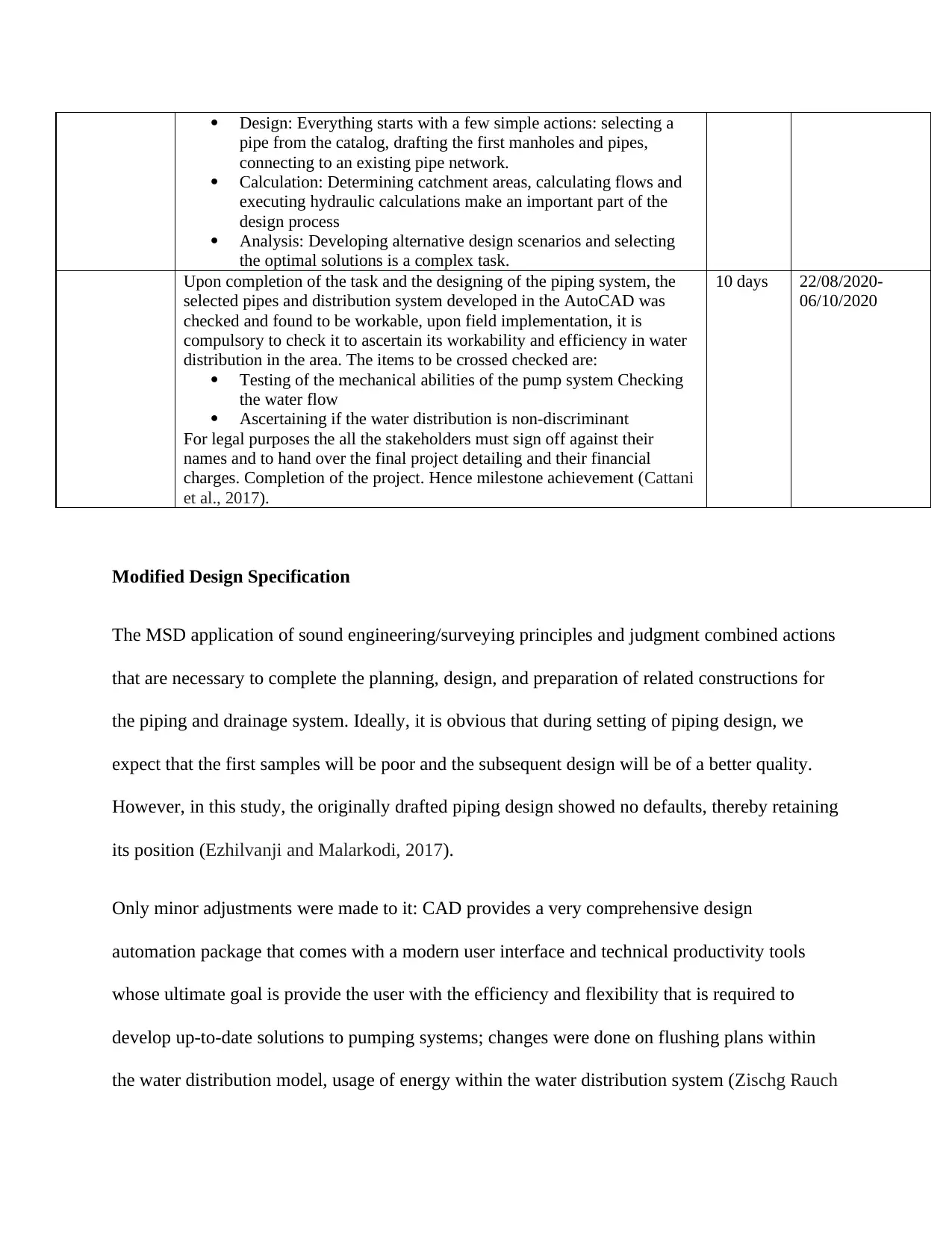
Design: Everything starts with a few simple actions: selecting a
pipe from the catalog, drafting the first manholes and pipes,
connecting to an existing pipe network.
Calculation: Determining catchment areas, calculating flows and
executing hydraulic calculations make an important part of the
design process
Analysis: Developing alternative design scenarios and selecting
the optimal solutions is a complex task.
Upon completion of the task and the designing of the piping system, the
selected pipes and distribution system developed in the AutoCAD was
checked and found to be workable, upon field implementation, it is
compulsory to check it to ascertain its workability and efficiency in water
distribution in the area. The items to be crossed checked are:
Testing of the mechanical abilities of the pump system Checking
the water flow
Ascertaining if the water distribution is non-discriminant
For legal purposes the all the stakeholders must sign off against their
names and to hand over the final project detailing and their financial
charges. Completion of the project. Hence milestone achievement (Cattani
et al., 2017).
10 days 22/08/2020-
06/10/2020
Modified Design Specification
The MSD application of sound engineering/surveying principles and judgment combined actions
that are necessary to complete the planning, design, and preparation of related constructions for
the piping and drainage system. Ideally, it is obvious that during setting of piping design, we
expect that the first samples will be poor and the subsequent design will be of a better quality.
However, in this study, the originally drafted piping design showed no defaults, thereby retaining
its position (Ezhilvanji and Malarkodi, 2017).
Only minor adjustments were made to it: CAD provides a very comprehensive design
automation package that comes with a modern user interface and technical productivity tools
whose ultimate goal is provide the user with the efficiency and flexibility that is required to
develop up-to-date solutions to pumping systems; changes were done on flushing plans within
the water distribution model, usage of energy within the water distribution system (Zischg Rauch
pipe from the catalog, drafting the first manholes and pipes,
connecting to an existing pipe network.
Calculation: Determining catchment areas, calculating flows and
executing hydraulic calculations make an important part of the
design process
Analysis: Developing alternative design scenarios and selecting
the optimal solutions is a complex task.
Upon completion of the task and the designing of the piping system, the
selected pipes and distribution system developed in the AutoCAD was
checked and found to be workable, upon field implementation, it is
compulsory to check it to ascertain its workability and efficiency in water
distribution in the area. The items to be crossed checked are:
Testing of the mechanical abilities of the pump system Checking
the water flow
Ascertaining if the water distribution is non-discriminant
For legal purposes the all the stakeholders must sign off against their
names and to hand over the final project detailing and their financial
charges. Completion of the project. Hence milestone achievement (Cattani
et al., 2017).
10 days 22/08/2020-
06/10/2020
Modified Design Specification
The MSD application of sound engineering/surveying principles and judgment combined actions
that are necessary to complete the planning, design, and preparation of related constructions for
the piping and drainage system. Ideally, it is obvious that during setting of piping design, we
expect that the first samples will be poor and the subsequent design will be of a better quality.
However, in this study, the originally drafted piping design showed no defaults, thereby retaining
its position (Ezhilvanji and Malarkodi, 2017).
Only minor adjustments were made to it: CAD provides a very comprehensive design
automation package that comes with a modern user interface and technical productivity tools
whose ultimate goal is provide the user with the efficiency and flexibility that is required to
develop up-to-date solutions to pumping systems; changes were done on flushing plans within
the water distribution model, usage of energy within the water distribution system (Zischg Rauch
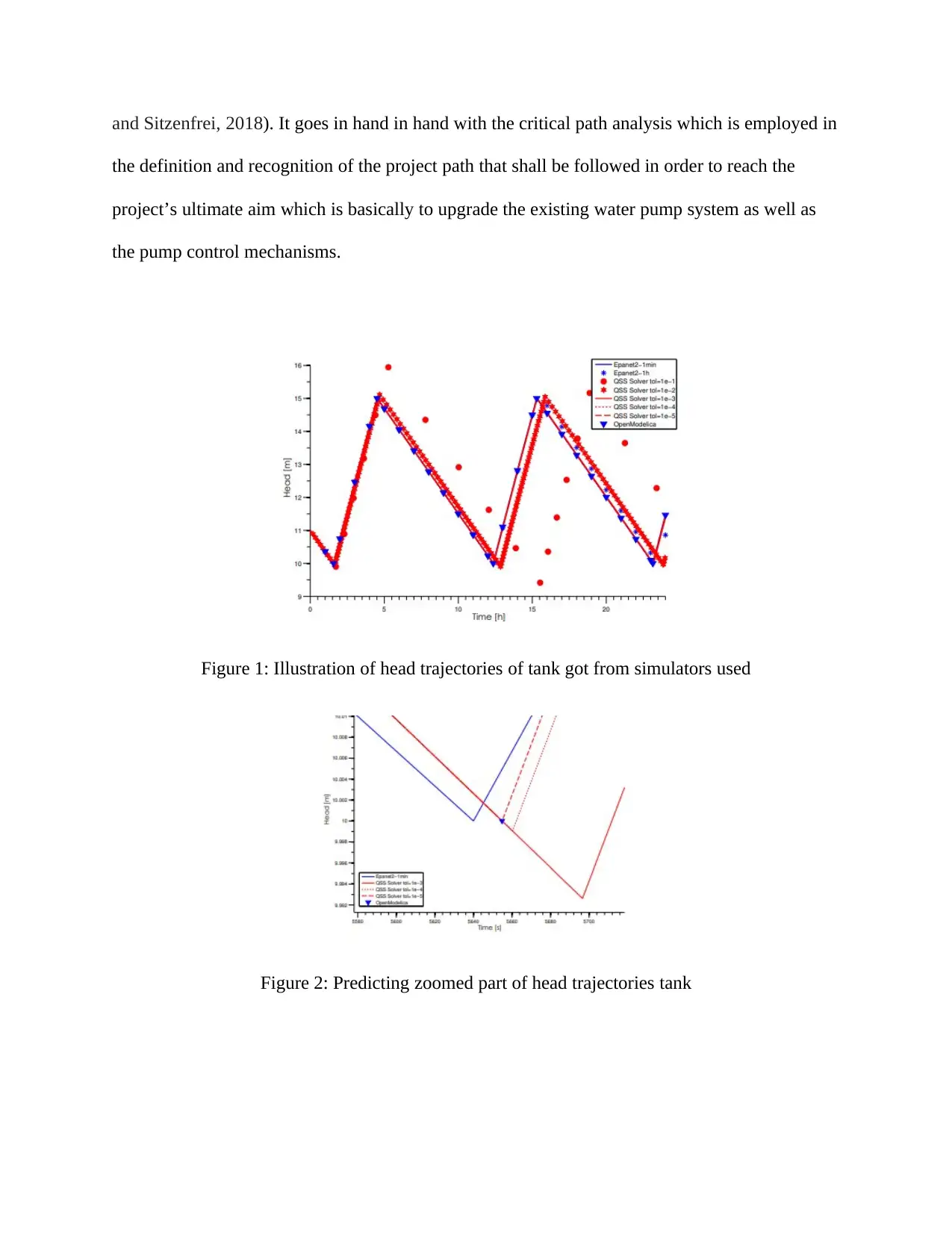
and Sitzenfrei, 2018). It goes in hand in hand with the critical path analysis which is employed in
the definition and recognition of the project path that shall be followed in order to reach the
project’s ultimate aim which is basically to upgrade the existing water pump system as well as
the pump control mechanisms.
Figure 1: Illustration of head trajectories of tank got from simulators used
Figure 2: Predicting zoomed part of head trajectories tank
the definition and recognition of the project path that shall be followed in order to reach the
project’s ultimate aim which is basically to upgrade the existing water pump system as well as
the pump control mechanisms.
Figure 1: Illustration of head trajectories of tank got from simulators used
Figure 2: Predicting zoomed part of head trajectories tank
⊘ This is a preview!⊘
Do you want full access?
Subscribe today to unlock all pages.

Trusted by 1+ million students worldwide
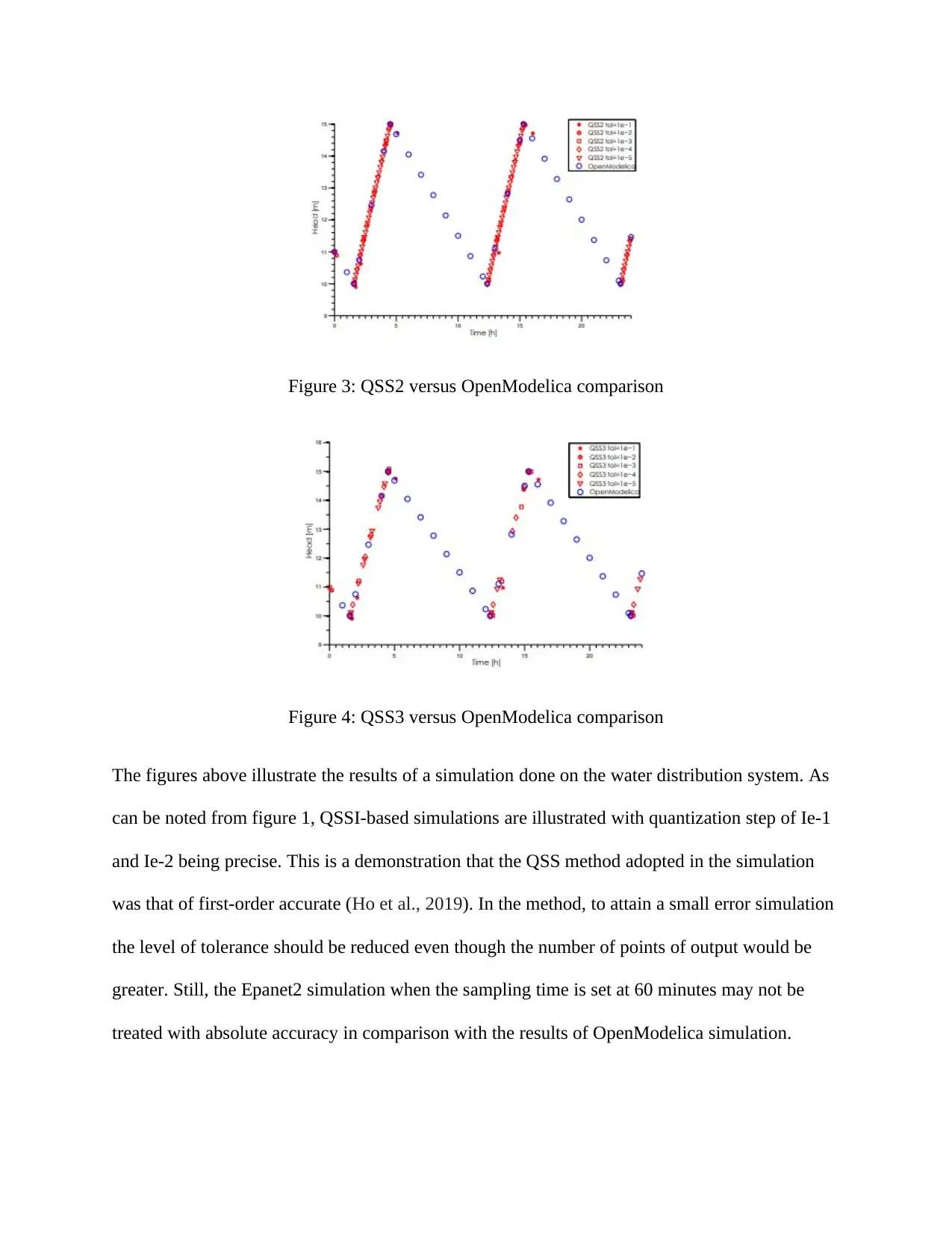
Figure 3: QSS2 versus OpenModelica comparison
Figure 4: QSS3 versus OpenModelica comparison
The figures above illustrate the results of a simulation done on the water distribution system. As
can be noted from figure 1, QSSI-based simulations are illustrated with quantization step of Ie-1
and Ie-2 being precise. This is a demonstration that the QSS method adopted in the simulation
was that of first-order accurate (Ho et al., 2019). In the method, to attain a small error simulation
the level of tolerance should be reduced even though the number of points of output would be
greater. Still, the Epanet2 simulation when the sampling time is set at 60 minutes may not be
treated with absolute accuracy in comparison with the results of OpenModelica simulation.
Figure 4: QSS3 versus OpenModelica comparison
The figures above illustrate the results of a simulation done on the water distribution system. As
can be noted from figure 1, QSSI-based simulations are illustrated with quantization step of Ie-1
and Ie-2 being precise. This is a demonstration that the QSS method adopted in the simulation
was that of first-order accurate (Ho et al., 2019). In the method, to attain a small error simulation
the level of tolerance should be reduced even though the number of points of output would be
greater. Still, the Epanet2 simulation when the sampling time is set at 60 minutes may not be
treated with absolute accuracy in comparison with the results of OpenModelica simulation.
Paraphrase This Document
Need a fresh take? Get an instant paraphrase of this document with our AI Paraphraser
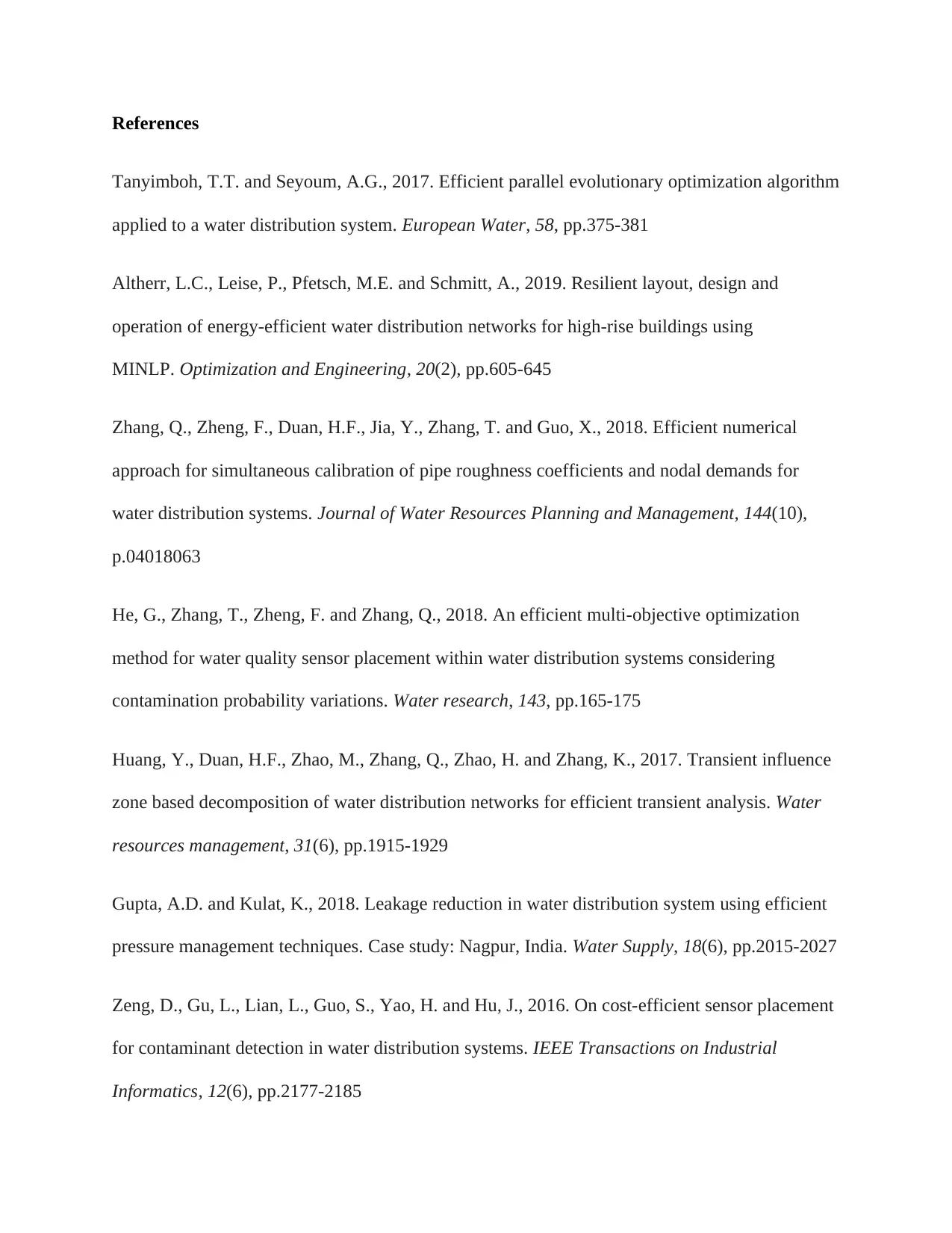
References
Tanyimboh, T.T. and Seyoum, A.G., 2017. Efficient parallel evolutionary optimization algorithm
applied to a water distribution system. European Water, 58, pp.375-381
Altherr, L.C., Leise, P., Pfetsch, M.E. and Schmitt, A., 2019. Resilient layout, design and
operation of energy-efficient water distribution networks for high-rise buildings using
MINLP. Optimization and Engineering, 20(2), pp.605-645
Zhang, Q., Zheng, F., Duan, H.F., Jia, Y., Zhang, T. and Guo, X., 2018. Efficient numerical
approach for simultaneous calibration of pipe roughness coefficients and nodal demands for
water distribution systems. Journal of Water Resources Planning and Management, 144(10),
p.04018063
He, G., Zhang, T., Zheng, F. and Zhang, Q., 2018. An efficient multi-objective optimization
method for water quality sensor placement within water distribution systems considering
contamination probability variations. Water research, 143, pp.165-175
Huang, Y., Duan, H.F., Zhao, M., Zhang, Q., Zhao, H. and Zhang, K., 2017. Transient influence
zone based decomposition of water distribution networks for efficient transient analysis. Water
resources management, 31(6), pp.1915-1929
Gupta, A.D. and Kulat, K., 2018. Leakage reduction in water distribution system using efficient
pressure management techniques. Case study: Nagpur, India. Water Supply, 18(6), pp.2015-2027
Zeng, D., Gu, L., Lian, L., Guo, S., Yao, H. and Hu, J., 2016. On cost-efficient sensor placement
for contaminant detection in water distribution systems. IEEE Transactions on Industrial
Informatics, 12(6), pp.2177-2185
Tanyimboh, T.T. and Seyoum, A.G., 2017. Efficient parallel evolutionary optimization algorithm
applied to a water distribution system. European Water, 58, pp.375-381
Altherr, L.C., Leise, P., Pfetsch, M.E. and Schmitt, A., 2019. Resilient layout, design and
operation of energy-efficient water distribution networks for high-rise buildings using
MINLP. Optimization and Engineering, 20(2), pp.605-645
Zhang, Q., Zheng, F., Duan, H.F., Jia, Y., Zhang, T. and Guo, X., 2018. Efficient numerical
approach for simultaneous calibration of pipe roughness coefficients and nodal demands for
water distribution systems. Journal of Water Resources Planning and Management, 144(10),
p.04018063
He, G., Zhang, T., Zheng, F. and Zhang, Q., 2018. An efficient multi-objective optimization
method for water quality sensor placement within water distribution systems considering
contamination probability variations. Water research, 143, pp.165-175
Huang, Y., Duan, H.F., Zhao, M., Zhang, Q., Zhao, H. and Zhang, K., 2017. Transient influence
zone based decomposition of water distribution networks for efficient transient analysis. Water
resources management, 31(6), pp.1915-1929
Gupta, A.D. and Kulat, K., 2018. Leakage reduction in water distribution system using efficient
pressure management techniques. Case study: Nagpur, India. Water Supply, 18(6), pp.2015-2027
Zeng, D., Gu, L., Lian, L., Guo, S., Yao, H. and Hu, J., 2016. On cost-efficient sensor placement
for contaminant detection in water distribution systems. IEEE Transactions on Industrial
Informatics, 12(6), pp.2177-2185
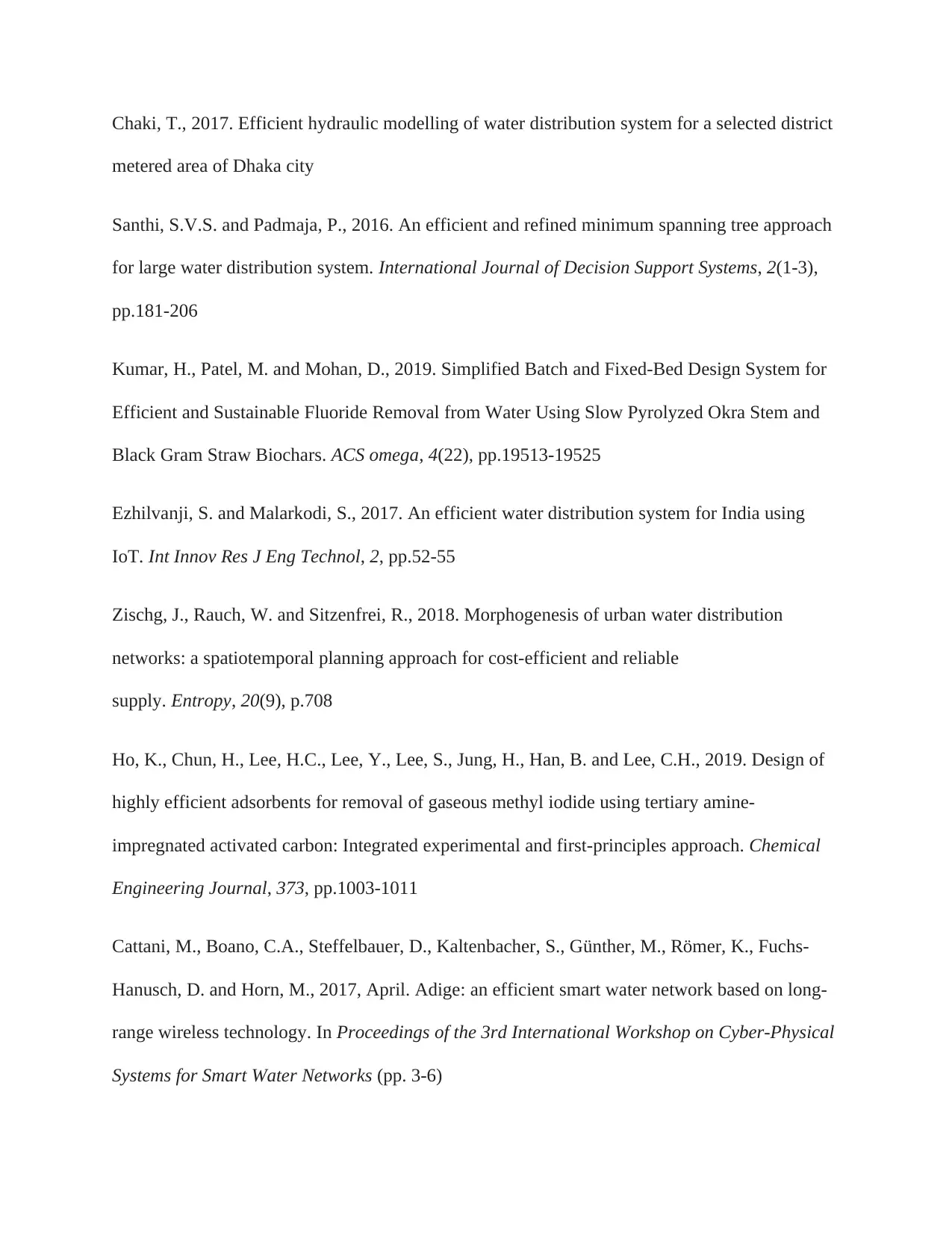
Chaki, T., 2017. Efficient hydraulic modelling of water distribution system for a selected district
metered area of Dhaka city
Santhi, S.V.S. and Padmaja, P., 2016. An efficient and refined minimum spanning tree approach
for large water distribution system. International Journal of Decision Support Systems, 2(1-3),
pp.181-206
Kumar, H., Patel, M. and Mohan, D., 2019. Simplified Batch and Fixed-Bed Design System for
Efficient and Sustainable Fluoride Removal from Water Using Slow Pyrolyzed Okra Stem and
Black Gram Straw Biochars. ACS omega, 4(22), pp.19513-19525
Ezhilvanji, S. and Malarkodi, S., 2017. An efficient water distribution system for India using
IoT. Int Innov Res J Eng Technol, 2, pp.52-55
Zischg, J., Rauch, W. and Sitzenfrei, R., 2018. Morphogenesis of urban water distribution
networks: a spatiotemporal planning approach for cost-efficient and reliable
supply. Entropy, 20(9), p.708
Ho, K., Chun, H., Lee, H.C., Lee, Y., Lee, S., Jung, H., Han, B. and Lee, C.H., 2019. Design of
highly efficient adsorbents for removal of gaseous methyl iodide using tertiary amine-
impregnated activated carbon: Integrated experimental and first-principles approach. Chemical
Engineering Journal, 373, pp.1003-1011
Cattani, M., Boano, C.A., Steffelbauer, D., Kaltenbacher, S., Günther, M., Römer, K., Fuchs-
Hanusch, D. and Horn, M., 2017, April. Adige: an efficient smart water network based on long-
range wireless technology. In Proceedings of the 3rd International Workshop on Cyber-Physical
Systems for Smart Water Networks (pp. 3-6)
metered area of Dhaka city
Santhi, S.V.S. and Padmaja, P., 2016. An efficient and refined minimum spanning tree approach
for large water distribution system. International Journal of Decision Support Systems, 2(1-3),
pp.181-206
Kumar, H., Patel, M. and Mohan, D., 2019. Simplified Batch and Fixed-Bed Design System for
Efficient and Sustainable Fluoride Removal from Water Using Slow Pyrolyzed Okra Stem and
Black Gram Straw Biochars. ACS omega, 4(22), pp.19513-19525
Ezhilvanji, S. and Malarkodi, S., 2017. An efficient water distribution system for India using
IoT. Int Innov Res J Eng Technol, 2, pp.52-55
Zischg, J., Rauch, W. and Sitzenfrei, R., 2018. Morphogenesis of urban water distribution
networks: a spatiotemporal planning approach for cost-efficient and reliable
supply. Entropy, 20(9), p.708
Ho, K., Chun, H., Lee, H.C., Lee, Y., Lee, S., Jung, H., Han, B. and Lee, C.H., 2019. Design of
highly efficient adsorbents for removal of gaseous methyl iodide using tertiary amine-
impregnated activated carbon: Integrated experimental and first-principles approach. Chemical
Engineering Journal, 373, pp.1003-1011
Cattani, M., Boano, C.A., Steffelbauer, D., Kaltenbacher, S., Günther, M., Römer, K., Fuchs-
Hanusch, D. and Horn, M., 2017, April. Adige: an efficient smart water network based on long-
range wireless technology. In Proceedings of the 3rd International Workshop on Cyber-Physical
Systems for Smart Water Networks (pp. 3-6)
⊘ This is a preview!⊘
Do you want full access?
Subscribe today to unlock all pages.

Trusted by 1+ million students worldwide
1 out of 12
Your All-in-One AI-Powered Toolkit for Academic Success.
+13062052269
info@desklib.com
Available 24*7 on WhatsApp / Email
![[object Object]](/_next/static/media/star-bottom.7253800d.svg)
Unlock your academic potential
Copyright © 2020–2025 A2Z Services. All Rights Reserved. Developed and managed by ZUCOL.

